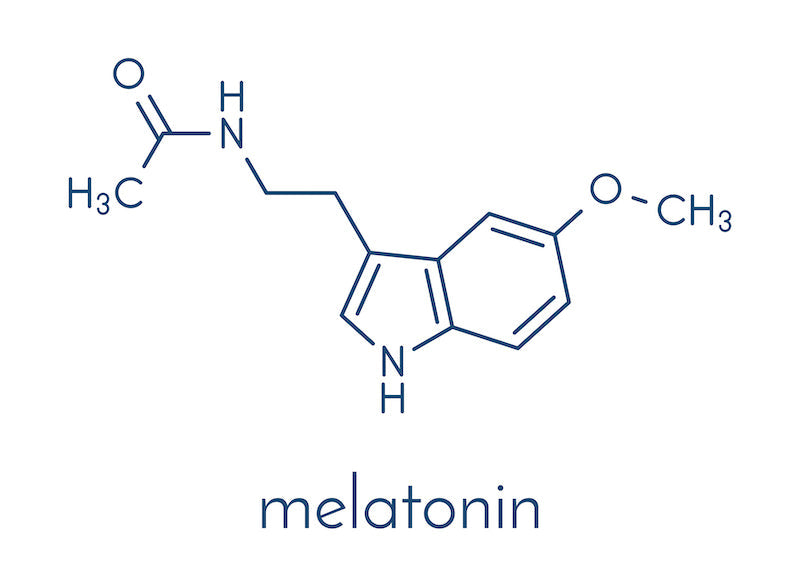
What do you know about melatonin? Almost everyone has heard of it, and knows a little bit about it. To most people, it is known as the sleep hormone, because it regulates our day/night circadian rhythm, and induces deep sleep in the absence of external light sources. However, what most people know about melatonin is just the tip of the iceberg, and the benefits of this endogenous neurohormone go SO much deeper!
Melatonin is also known as N-acetyl-5-methoxytryptamine. Most of the body’s melatonin is produced in the pineal gland, which is a small gland that resides in the middle of the brain, although not inside the blood brain barrier like most of the brain. Melatonin that is produced endogenously (by the body itself) begins from tryptophan (an essential amino acid) derived from dietary sources, then goes through several conversions that utilize nutrient cofactors also sourced from the diet, including niacin, magnesium, iron, vitamin C and zinc. If all of these nutrients are continually present in sufficient quantities, AND there is adequate darkness during the nighttime hours, melatonin will be secreted into the bloodstream in optimal amounts. One intermediary step in the conversion of tryptophan to melatonin within the pineal gland is the creation of serotonin, an essential neurotransmitter that regulates mood, memory, learning, body weight and much more.
Why is melatonin so important? Many consider melatonin to be one of the body’s master hormones, possibly even the single most important one, when considering all of its roles in the body. It is considered a neurohormone, which means that it’s secreted into the bloodstream for systemic use (like a hormone), but it also plays the role of a neurotransmitter. It can be considered to be the body’s master antioxidant, and it promotes the expression of other endogenous antioxidants like superoxide dismutase (SOD) and glutathione. It has been proven to be twice as active as vitamin E, which is considered a lipophilic super antioxidant. It is also a potent anti-inflammatory substance, and has wide ranging systemic benefits to every single bodily system and function. The importance of this molecule cannot be overstated!
Melatonin is also considered the ultimate anti-stress hormone, since it opposes cortisol in the circadian cycle. Light stimulates cortisol, and darkness stimulates melatonin. Melatonin should be present in our bloodstream in adequate levels throughout the night, then when light reaches our eyes in the morning, this sends a message to our pineal gland to shut off melatonin production, triggering the production of cortisol in our adrenal glands. This gives us the energy boost and motivation needed to get out of bed and start our day. We actually want this cortisol boost in the morning hours, as it’s the “get up and go” hormone! However, too much cortisol later in the day is very stressful to the body, and prevents relaxation and healing.
Although much of the body’s melatonin is secreted in the pineal gland in response to darkness cues, there is a vast quantity of melatonin produced in the gut as a protective agent and to encourage the propagation of healthy gut flora. Additionally, melatonin is produced in all of the body’s mitochondria (which produce the energy that fuels every single bodily process), specifically to quench the oxidation and inflammation that’s an unavoidable byproduct of our cellular energy production itself. If melatonin is lacking in the mitochondria, toxic waste and inflammation will clog up our cells over time, leading to a systemic energy deficiency and toxic buildup.
Melatonin is a vital player in our immune function, to ensure that it responds quickly and strongly to fight off invaders, AND calms down as soon as the invaders are defeated. If the immune system is dysfunctional, it can overreact and continue to produce inflammatory cytokines even when the invading microbes are gone, contributing to dangerous chronic inflammation that can lead to autoimmune conditions and “cytokine storms”. As one of our main endogenous anti-inflammatory agents, it plays the role of calming unneeded inflammatory cytokines and restoring immune homeostasis to prevent exhaustion from an overactive or chronic immune response.
Melatonin is destroyed by light and EMFs
Now that we’ve established the vital importance of melatonin to our overall health, we need to acknowledge an unfortunate truth: several prominent aspects of our modern lifestyles considerably deplete melatonin. Early in the day, exposure to light is important and totally necessary to build up our serotonin reserves. Then, when darkness comes, a large quantity of this serotonin is converted to melatonin, flooding our bloodstream with that cozy, sleepy feeling, ensuring that we get adequate deep sleep at night. However, this natural circadian cycle is easily disrupted. If you are exposed to artificial light sources at night, specifically in the higher frequency blue and green portions of the light spectrum, melatonin release will be suppressed, and will not occur in optimal quantities to achieve deep sleep and the healing and regenerative cascade that results from adequate sleep. Also, when darkness is provided adequately at night and melatonin begins to be released into your bloodstream, and then you are suddenly exposed to light (like turning on a light to go to the bathroom in the middle of the night), it has been shown that melatonin in the bloodstream quickly disappears. Basically, light exposure inhibits melatonin release, and almost instantaneously destroys any melatonin that is currently circulating.
Fortunately, the effects of artificial light on melatonin has become much more widely known in recent years! There are several excellent solutions to this, including switching out your nighttime lighting to the orange or red light spectrum (which has little to no effect on melatonin), using dimmer switches to reduce the intensity of light in the evening hours, or wearing “blue blocking” glasses if you have to be exposed to the brighter spectrum of light after dark.
A much lesser known melatonin disruptor is electromagnetic fields. The exact mechanism of why EMFs decrease and interrupt melatonin production is not fully known, but it is theorized that the pineal gland perceives EMFs as a form of light that artificially stimulates wakefulness and prevents or interrupts restful sleep. Although the mechanism hasn’t been concretely established, there are quite a large number of studies that have established a causal relationship between EMFs and reduced melatonin levels.
Several studies have linked EMFs with reduced calcium ion homeostasis in cells, which also reduces melatonin as a byproduct. Disturbances in the sensitive voltage-gated calcium channels (VGCCs) produce large quantities of free radicals, and it could be that melatonin, the body’s primary antioxidant, is being used up to quench this excessive oxidation, leaving very little melatonin left to be used for sleep, regeneration and other essential daily functions.
Here are a couple of reviews of many separate studies linking EMFs, VGCCs and reduced melatonin levels:
- Pineal Melatonin Levels Disruption on Human Due to Electromagnetic Fields and ICNIRP Limits
- Skeptical approaches concerning the effect of exposure to electromagnetic fields on brain hormones and enzyme activities
In addition to those, there are dozens more studies that separately link EMFs with reduced melatonin levels, and EMFs with voltage-gated calcium channel disturbances. The studies that have linked EMF exposure with VGCC disturbance (especially Dr. Martin Pall’s research) found that it’s something about the way these artificial EMFs are structured (how they are modulated and pulsed to carry wireless information) that causes the calcium channel flooding and resulting oxidative stress. This may be why natural electromagnetic fields from the Earth and cosmos do not have the same harmful effect – they are structured differently, and the body generally does not perceive these natural frequencies as a threat, with some exceptions (excessive ionizing radiation from the sun, and geopathic stress caused by specific areas of disturbance in the Earth’s magnetic field).
Optimal melatonin levels protect from the harmful effects of EMFs
It has been established that modern day artificial electromagnetic fields reduce our endogenous melatonin production, most likely through the mechanism of calcium channel flooding. In an ultimate catch 22 situation, many other studies have also established that optimal melatonin levels have powerful protective effects against these exact same EMFs.
Just to clarify, one of the most powerful natural substances capable of protecting us from EMF harm is being actively depleted by these same EMFs! This is definitely a conundrum.
Here are just a few (of many!) studies that demonstrate the protective effects of melatonin against harm from electromagnetic fields:
- Melatonin modulates wireless (2.45 GHz)-induced oxidative injury through TRPM2 and voltage gated Ca2+ channels in brain and dorsal root ganglion in rat
- Melatonin reduces oxidative stress induced by chronic exposure of microwave radiation from mobile phones in rat brain
- Melatonin modulates 900 Mhz microwave-induced lipid peroxidation changes in rat brain
- Oxidative stress-mediated skin damage in an experimental mobile phone model can be prevented by melatonin
What can we do about this? Obviously, protecting our melatonin becomes vitally important, especially if we are EMF hypersensitive, or simply interested in optimal health and longevity. The vicious cycle of EMF induced melatonin depletion and the subsequent increase in oxidation and inflammation, which leads to increased EMF reactivity, needs to be halted for balance to be achieved.
Since this stress cycle has been well underway for a long time for most modern humans, and our lifestyles inherently increase this stress from multiple angles, achieving homeostasis needs to be a multifaceted approach.
The “melatonin pyramid” found in this melatonin study is quite helpful for understanding the multiple steps that need to be taken to optimize melatonin levels:

Obviously, the most important factor in optimal natural melatonin production is having adequate darkness at night. This means you need to protect your sleep space by ensuring there are no lights in your bedroom, and that you aren’t exposed to any bright lights during the night – a small red light can be helpful if you need to use a nightlight during the night. This also means you want to keep your home lights as dim as possible within a couple hours of bedtime. Having a cap on electronic device use at night is also important, as our computer and cell phone screens emit very high frequency blue light. If you need to look at your phone or computer in the evening, there are dimming mechanisms and apps you can use to reduce the brightness of your screen to as low levels as possible.
Next, to ensure that your body has the raw materials to produce enough melatonin, make sure you are getting enough protein in your diet, especially tryptophan. The body cannot synthesize tryptophan and needs to get it from dietary sources. Additionally, your body needs plenty of the vitamin and mineral cofactors mentioned at the beginning of this article, which are essential in the conversion from tryptophan to serotonin and melatonin, so eating a nutrient rich diet is essential!
Consuming plenty of anti-inflammatory foods helps take the burden off your melatonin, so it isn’t solely responsible for quenching all oxidative stress in your body, making more melatonin available for other essential processes. Also, many plant foods (including nuts, cherries and rice) contain small amounts of melatonin, since plants produce melatonin as part of their own defense against oxidative stress. By eating these plants, we can get minute amounts of melatonin directly, bypassing the normal conversion process.
Lastly, if we really need a boost to get back on track, there are high quality melatonin supplements on the market that can be worth experimenting with. Melatonin is extremely well studied, has a high safety profile, and contrary to common belief, supplementing does not decrease your endogenous melatonin production.
Using Blushield to protect your melatonin
Of course, there is one more section we would add to the melatonin pyramid: using Blushield devices in your home, especially at night during sleep!
As noted above, manmade electromagnetic fields (especially from wireless devices) cause calcium channel flooding, massively increasing oxidative stress, but natural electromagnetic fields from the Earth do not have this effect. Blushield devices emit a field that’s very similar to the frequencies found in nature, and have been shown in our human and animal tests to calm the overactive immune response and restore normal cellular function. As a byproduct, this will protect and conserve our melatonin levels, as our melatonin will not need to be used up to quench the stress from the EMFs!
One of the most common reports we get from Blushield users is deeper and more restful sleep, either immediately or after the initial acclimation period. This is most likely due to the increase in available melatonin that the body is no longer using up to quench the fires of oxidation due to our own excessive immune response, which can then be used for the vital regenerative process of sleep. Consistent high quality sleep improves health in every way, and can protect against chronic and degenerative disease.
One of the beautiful things about the winter months is the increased hours of darkness, which under ideal circumstances would allow us to deeply restore and regenerate our bodies from the stresses of the brighter, more active times of the year, healing and preparing us for another cycle of increased light and activity! Optimizing our sleep during the winter is an amazing health and longevity strategy that takes nature’s own most powerful cycle into consideration.

